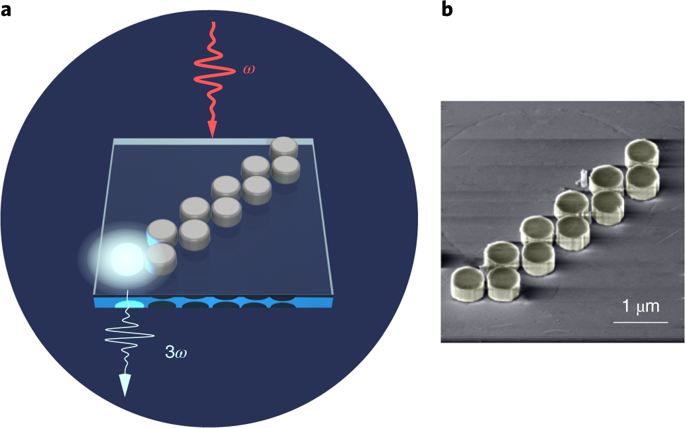Nature Nanotechnology ( IF 38.1 ) Pub Date : 2018-12-17 , DOI: 10.1038/s41565-018-0324-7 Sergey Kruk , Alexander Poddubny , Daria Smirnova , Lei Wang , Alexey Slobozhanyuk , Alexander Shorokhov , Ivan Kravchenko , Barry Luther-Davies , Yuri Kivshar

|
Topological photonics has emerged as a route to robust optical circuitry protected against disorder1,2 and now includes demonstrations such as topologically protected lasing3,4,5 and single-photon transport6. Recently, nonlinear optical topological structures have attracted special theoretical interest7,8,9,10,11, as they enable tuning of topological properties by a change in the light intensity7,12 and can break optical reciprocity13,14,15 to realize full topological protection. However, so far, non-reciprocal topological states have only been realized using magneto-optical materials and macroscopic set-ups with external magnets4,16, which is not feasible for nanoscale integration. Here we report the observation of a third-harmonic signal from a topologically non-trivial zigzag array of dielectric nanoparticles and the demonstration of strong enhancement of the nonlinear photon generation at the edge states of the array. The signal enhancement is due to the interaction between the Mie resonances of silicon nanoparticles and the topological localization of the electric field at the edges. The system is also robust against various perturbations and structural defects. Moreover, we show that the interplay between topology, bi-anisotropy and nonlinearity makes parametric photon generation tunable and non-reciprocal. Our study brings nonlinear topological photonics concepts to the realm of nanoscience.
中文翻译:

拓扑纳米结构中的非线性光产生
拓扑光子学已经成为通向强大的光学电路的保护之道,以防止受到1,2级疾病的困扰,现在包括诸如拓扑受保护的激射3、4、5和单光子传输6之类的演示。最近,非线性光学拓扑结构吸引了特殊的理论兴趣7,8,9,10,11,因为它们可以通过改变光强度7,12来调整拓扑特性,并且可以破坏光学互易性13,14,15以实现全面的拓扑保护。但是,到目前为止,只有使用磁光材料和带有外部磁体的宏观结构才能实现不可逆的拓扑状态4,16,这对于纳米级集成是不可行的。在这里,我们报告了从介电纳米粒子的拓扑非平凡的之字形阵列中观察到的三次谐波信号,并展示了在阵列边缘状态处非线性光子产生的强烈增强。信号增强归因于硅纳米粒子的米氏共振与电场在边缘的拓扑局部化之间的相互作用。该系统还可以抵抗各种干扰和结构缺陷。此外,我们表明,拓扑,双各向异性和非线性之间的相互作用使参数光子的生成可调且不可逆。我们的研究将非线性拓扑光子学概念带入了纳米科学领域。











































 京公网安备 11010802027423号
京公网安备 11010802027423号